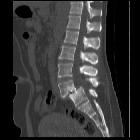spondylolisthesis grading system

Spondylolisthesis
grading system • Spondylolisthesis grading (illustration) - Ganzer Fall bei Radiopaedia

Spondylolisthesis
grading system • Spondylolysis and spondylolisthesis - Ganzer Fall bei Radiopaedia

Spondylolisthesis
grading system • L4-L5 spondylolisthesis: grade II - Ganzer Fall bei Radiopaedia

Spondylolisthesis
grading system • Spondylolisthesis - grade IV - Ganzer Fall bei Radiopaedia
A commonly adopted method of grading the severity of spondylolisthesis is the Meyerding classification. It divides the superior endplate of the vertebra below into 4 quarters. The grade depends on the location of the posteroinferior corner of the vertebra above.
This classification was originally developed for anterolistheses but can be adapted for retrolistheses, and some publications have done so .
- grade I: 0-25%
- grade II: 26-50%
- grade III: 51-75%
- grade IV: 76-100%
- grade V (spondyloptosis): >100%
History and etymology
The grading system is named after its inventor Henry W Meyerding (1884 - 1969), who was an American orthopedic surgeon at the Mayo Clinic, Rochester, Minnesota. He proposed the classification in an article in 1932 .
Siehe auch:
- Spondylolisthesis
- Spinalkanalstenose
- Spondyloptose
- umgedrehtes Napoleon-Hut-Zeichen
- Wiltse Klassifikation der Spondylolisthesis
- anterior displacement measurement Taillard
- pseudospondylolisthesis
und weiter:

 Assoziationen und Differentialdiagnosen zu Schweregrad Spondylolithesis nach Meyerding:
Assoziationen und Differentialdiagnosen zu Schweregrad Spondylolithesis nach Meyerding:


